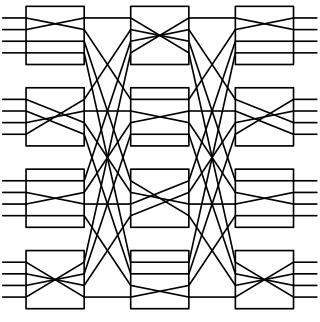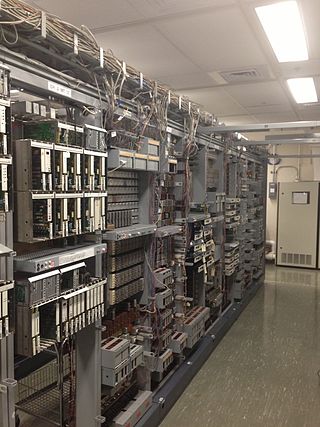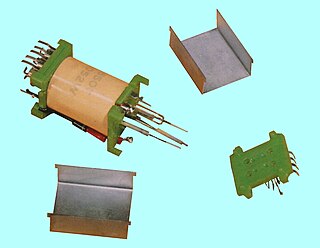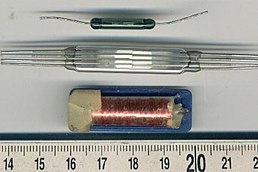
A relay is an electrically operated switch. It consists of a set of input terminals for a single or multiple control signals, and a set of operating contact terminals. The switch may have any number of contacts in multiple contact forms, such as make contacts, break contacts, or combinations thereof.
In electrical engineering, a switch is an electrical component that can disconnect or connect the conducting path in an electrical circuit, interrupting the electric current or diverting it from one conductor to another. The most common type of switch is an electromechanical device consisting of one or more sets of movable electrical contacts connected to external circuits. When a pair of contacts is touching current can pass between them, while when the contacts are separated no current can flow.
In telecommunications, an electronic switching system (ESS) is a telephone switch that uses solid-state electronics, such as digital electronics and computerized common control, to interconnect telephone circuits for the purpose of establishing telephone calls.

In electronics and telecommunications, a crossbar switch is a collection of switches arranged in a matrix configuration. A crossbar switch has multiple input and output lines that form a crossed pattern of interconnecting lines between which a connection may be established by closing a switch located at each intersection, the elements of the matrix. Originally, a crossbar switch consisted literally of crossing metal bars that provided the input and output paths. Later implementations achieved the same switching topology in solid-state electronics. The crossbar switch is one of the principal telephone exchange architectures, together with a rotary switch, memory switch, and a crossover switch.

A nonblocking minimal spanning switch is a device that can connect N inputs to N outputs in any combination. The most familiar use of switches of this type is in a telephone exchange. The term "non-blocking" means that if it is not defective, it can always make the connection. The term "minimal" means that it has the fewest possible components, and therefore the minimal expense.
Twistor memory is a form of computer memory formed by wrapping magnetic tape around a current-carrying wire. Operationally, twistor was very similar to core memory. Twistor could also be used to make ROM memories, including a re-programmable form known as piggyback twistor. Both forms were able to be manufactured using automated processes, which was expected to lead to much lower production costs than core-based systems.

The reed switch is an electromechanical switch operated by an applied magnetic field. It was invented in 1922 by professor Valentin Kovalenkov at the Petrograd Electrotechnical University, and later evolved at Bell Telephone Laboratories in 1936 by Walter B. Ellwood into the reed relay. In its simplest and most common form, it consists of a pair of ferromagnetic flexible metal contacts in a hermetically sealed glass envelope. The contacts are usually normally open, closing when a magnetic field is present, or they may be normally closed and open when a magnetic field is applied. The switch may be actuated by an electromagnetic coil, making a reed relay, or by bringing a permanent magnet near it. When the magnetic field is removed, the contacts in the reed switch return to their original position. The "reed" is the metal part inside the reed switch envelope that is relatively thin and wide to make it flexible, resembling the reed of a musical instrument. The term "reed" may also include the external wire lead as well as the internal part.
SP-1 was the name of a computerized telephone exchange manufactured by Northern Electric in Canada. It was introduced in 1971

A wire spring relay is a type of relay, that has springs made from drawn wires of nickel silver, rather than cut from flat sheet metal as in the flat-spring relay. This class of relays provided manufacturing and operating advantages over previous designs. Wire spring relays entered mass production in the early 1950s.
In telecommunication, supervision is the monitoring of a telecommunication circuit for telephony to convey to an operator, user, or a switching system, information about the operational state of the circuit. The typical operational states of trunks and lines are the idle and busy states, seizure, and disconnect. The states are indicated by various electrical signals and electrical conditions depending on the type of circuit, the type of terminating equipment, and the type of intended service.
The Number Five Crossbar Switching System is a telephone switch for telephone exchanges designed by Bell Labs and manufactured by Western Electric starting in 1947. It was used in the Bell System principally as a Class 5 telephone switch in the public switched telephone network (PSTN) until the early 1990s, when it was replaced with electronic switching systems. Variants were used as combined Class 4 and Class 5 systems in rural areas, and as a TWX switch.
The Number One Crossbar Switching System (1XB), was the primary technology for urban telephone exchanges served by the Bell System in the mid-20th century. Its switch fabric used the electromechanical crossbar switch to implement the topology of the panel switching system of the 1920s. The first No. 1 Crossbar was installed in the PResident-2 central office at Troy Avenue in Brooklyn, New York which became operational in February 1938.

The Number One Electronic Switching System (1ESS) was the first large-scale stored program control (SPC) telephone exchange or electronic switching system in the Bell System. It was manufactured by Western Electric and first placed into service in Succasunna, New Jersey, in May 1965. The switching fabric was composed of a reed relay matrix controlled by wire spring relays which in turn were controlled by a central processing unit (CPU).

TXE, was a family of telephone exchanges developed by the British General Post Office (GPO), designed to replace the ageing Strowger switches.

Bloomfield James Warman was an English electrical engineer. He was involved with the design of electronic telephone exchanges in the 1960s and 1970s. He was responsible for the concept of both the TXE1 and TXE3 systems, which were reed switch-based electronic exchanges. The development of these exchanges was carried out by a consortium of British telecom manufacturers in conjunction with the General Post Office. The ideas in these exchanges were later developed, by others, into the TXE4 exchanges - which, at their peak in the early 1990s, catered for more than 25% of the UK subscribers.
A junctor is a circuit used in analog telephone exchanges, including the Number One Crossbar Switching System, Number Five Crossbar Switching System, 1ESS switch and other switches.

A telephone exchange, telephone switch, or central office is a telecommunications system used in the public switched telephone network (PSTN) or in large enterprises. It interconnects telephone subscriber lines or virtual circuits of digital systems to establish telephone calls between subscribers.
Automatic test system switching test equipment allows for high-speed testing of a device or devices in a test situation, where strict sequences and combinations of switching must be observed. By automating the process in this way, the possibility of test errors and inaccuracies is minimized, and only systematic errors would generally be encountered due to such as an incorrect programmed test condition. This eliminates error due to human factors and allows application of a standard test sequence repetitively. The design of a test system’s switching configuration is governed by the test specification, which is derived from the functional tests to be performed.
A Dimond ring or Dimond ring translator was an early type of computer memory, created in the early 1940s by T. L. Dimond at Bell Laboratories for Bell's #5 Crossbar Switch, a type of early telephone switch.









